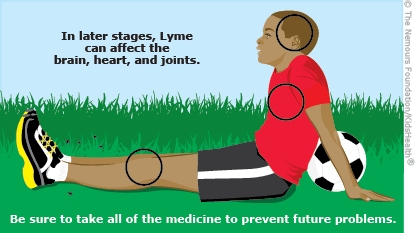Lyme disease is an illness caused by a type of bacteria (germ). The bacteria can spread to humans through the bite of a tiny deer tick (also called a black-legged tick). Lyme disease usually can be treated successfully with a few weeks of antibiotics. The sooner you treat it, the fewer long-term problems it will cause.



Your child:

Your child:

How do kids get Lyme disease? Ticks that carry the bacteria that cause Lyme disease live in tall grass and bushes. They spread the bacteria by biting into someone's skin. An infected tick must be attached for at least 1–2 days to pass the bacteria.
What are the symptoms of Lyme disease? Symptoms of Lyme disease appear within days to weeks of a tick bite. The first signs include:
Some symptoms like tiredness or pain take several weeks or months to go away, even after treatment. This does not mean that more antibiotics are needed.
If Lyme disease is not treated, skin rashes may appear on other body parts. The infection also can affect the nerves, brain, heart, and joints, leading to: